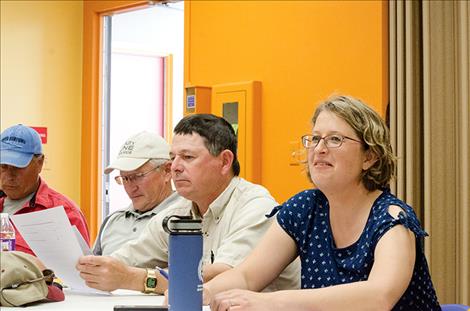Board hears about successful wildlife management programs
Hey savvy news reader! Thanks for choosing local.
You are now reading
1 of 3 free articles.
POLSON – The Flathead Reservation Fish and Wildlife Board met to talk about the many projects that happened last year and what will come in the future during a meeting on Wednesday, May 23, at the Polson library.
The State of Montana and the Confederated Salish and Kootenai Tribes started the board to help develop cooperative management plans on the reservation. Among other things, the group is tasked with developing fishing and bird hunting regulations. The tribal council appoints three members of the board and the state’s governor appoints another three. The seventh member is an employee of the United States Fish and Wildlife Service.
It was announced that license sales on the reservation were up during the 2017-18 year to $549,381, almost $20,000 more than the previous year. Residents and nonresidents purchased different licenses including conservation permits, fishing stamps, and bird stamps. License proceeds are used for conservation and hiring game wardens.
Germaine White, information and education program manager for CSKT, reported to the board that Fish, Wildlife and Parks and the tribes are working together to prevent aquatic invasive species under the direction of Tom McDonald.
McDonald, CSKT Natural Resources department manager, said public education concerning AIS has been successful. He said two years ago he could ask any random person what an invasive mussel was and they wouldn’t know, but today, most people are aware of the problem.
White said she wants to take the AIS program even further in the future with a strong northern perimeter and by building a permanent check station on tribal grounds in St. Ignatius. She said she was happy to announce the Ravalli check station was now open 24-hours a day, seven days a week.
Fisheries Program Manager Les Everts gave a presentation about habitat protection and restoration. He said 2017 was a slow year. The program was able to acquire 30 acres in the Jocko area by the river for the purpose of habitat restoration. Restoration is also being done to improve grizzly bear and trout habitat in the Post Creek area.
Evertz said it would be simple to remove cows in these areas so that the habitat developed naturally, but people’s livelihoods needed to be considered. He said the tribe purchased two ranches in the Jocko area and put up fences for cow grazing in an effort to protect riparian areas.
Another project included putting tracking radios on three 5-year-old native trout to see where they end up. Evertz said the fish didn’t make it very far before dying. One of the fish ended up in an osprey nest and another made it to a mink hole.
Reducing the number of lake trout in the Flathead Lake has been a successful project since 2002, he said. During the 2017 Mack Days, 51,923 lake trout were removed from the lake due to the efforts of 125 anglers. Suppression netting is also used to catch lake trout with 190-miles of netting. The netting project removed 22,000 lake trout.
“We are not seeing an increase in lake trout, which is showing that we are having an impact (on reducing non-native species),” he said.
CSKT sells the lake trout caught with nets and some of the ones caught during Mack Days to restaurants and grocery stores through their nonprofit operation called Native Fish Keepers, Inc.
“One of the largest threats to native bull trout and westslope cutthroat trout is predation by non-native lake trout,” according to Native Fish Keepers information. “The program to suppress lake trout is expensive; it requires multiple boats, extensive fishing gear, numerous personnel, and most importantly, it must go on perpetually. To help offset the costs of suppression, the tribes established Native Fish Keepers, Inc.”
Dale Becker, CSKT Natural Resource Department wildlife program manager, said prescribed burns have been underway on the reservation to help develop native plant populations. The swan population is on an upward trend with nesting currently taking place. Work is also being done to reintroduce the leopard frog. Populations of osprey and bald eagles are also increasing.

















